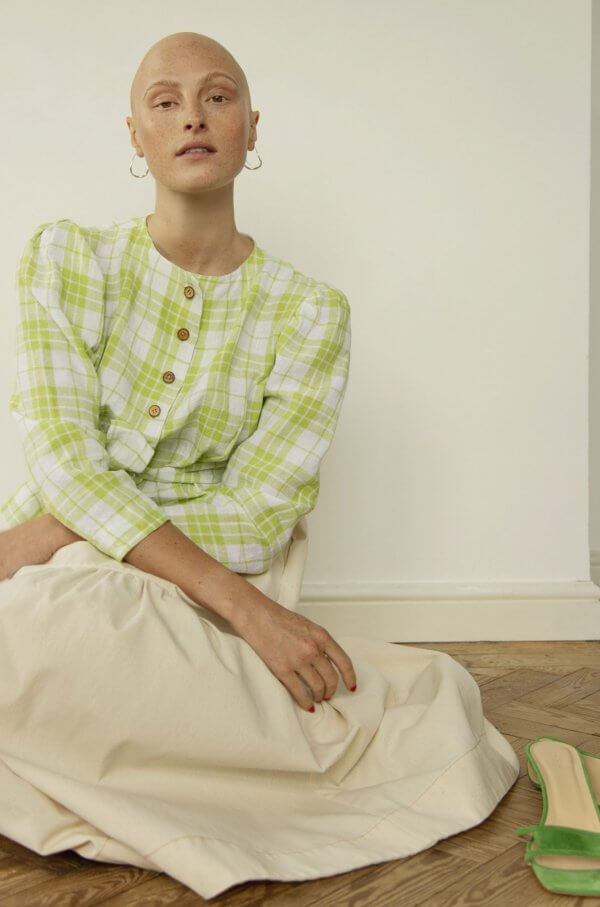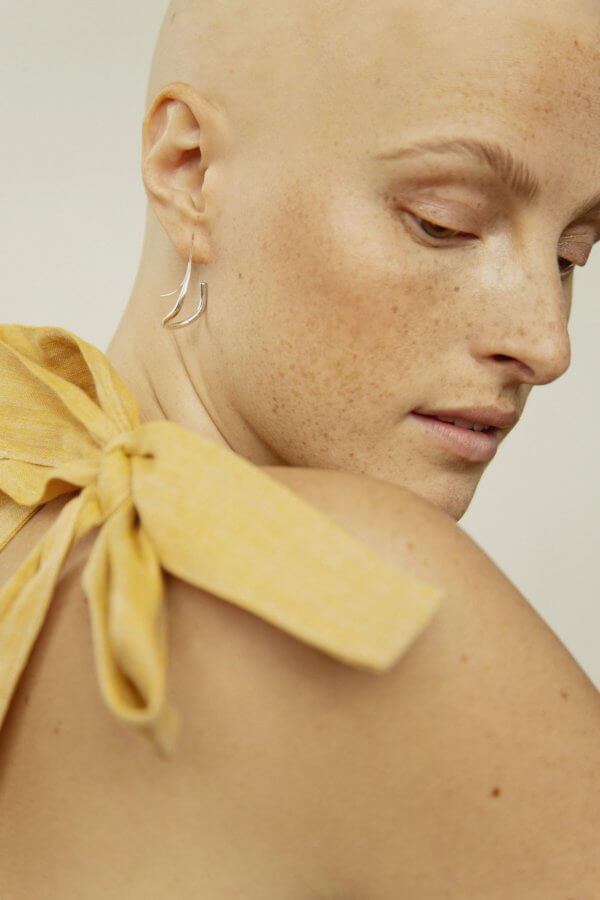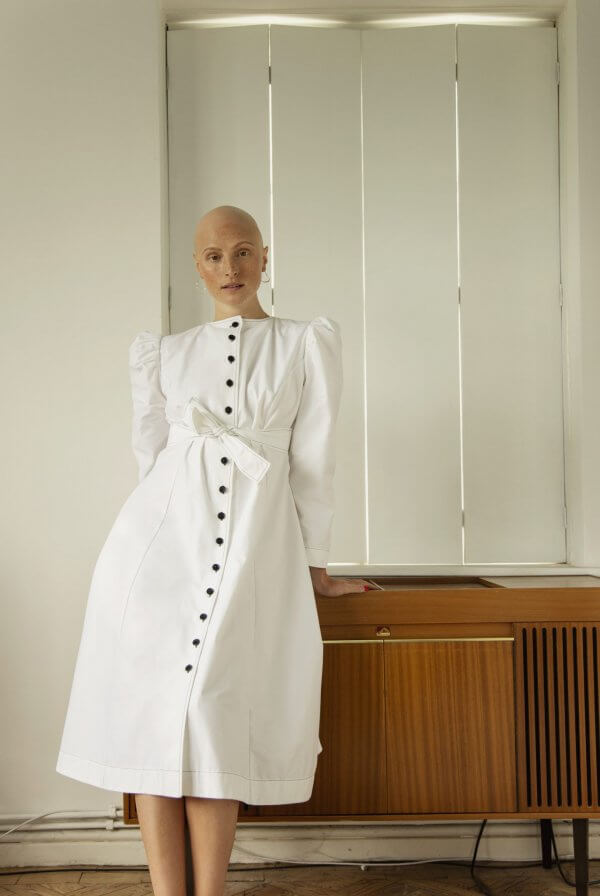Amber Rowan for Glasshouse Journal
Amber Rowan by Thea Lovstad
We understand all too well how much the hair on our head can mean to us. Society, tradition, gender – all these things and more have meant that in western society, it’s easy to have a big part of our identity wrapped up in our hair. The way we wear our hair can hold connotations too, from the ‘blondes have more fun’ style of stereotype to the idea that long hair equals femininity or a skinhead equals toughness.
Model and actress Amber Rowan developed alopecia when she was in her teens, losing all of her hair by the age of 15. Over ten years on, she runs her own platform, Hair Free Life, where she aims to speak openly and honestly about a topic she wishes she had access to more relatable advice and information back when she developed the syndrome. Amber has proved that losing your hair doesn’t mean losing your identity – in fact, her strength and true, genuine authenticity has illustrated exactly the opposite.
We spent a Summer morning with Amber and Glasshouse-favourite photographer Thea Lovstad, capturing Amber’s unique beauty and having a chat about her journey with alopecia, mental health and always being true to yourself.

Tell us about when you lost your hair and what that experience was like.
I lost my hair when I was 15. I was in the middle of a History class when one of my best friends found a corn-sized patch on the back of my head – it was like the smallest patch you’d ever seen. At the time, truly, I did not think anything of it – it was one of those freak things that didn’t panic me.
I was young so I’d never heard the term alopecia, it wasn’t something that was in my realm – when you’re 15 that’s the last thing you’re thinking of. So I literally put it to the back of my mind. In a way, it was an in-joke amongst me and my friends for the first couple of weeks whilst we were still figuring out what it was. It got a little more serious – I went to the doctor and then my mind quickly shifted to ‘oh god what if this gets bigger?’. I looked at it again and I kept looking at it daily, noticing it was getting bigger, which jolted me a bit. Me and Mum decided we might as well go and check it out.
What happened next?
So we went to the doctor and we were told it was alopecia. The doctors said to me generically ‘look, girls get this when they go through hormonal changes or if they’re stressed’. I was very thin at the time so they thought it was an accumulation of me getting my periods, being thin and going through hormonal changes. I was always very much an anxious kid so perhaps my body was trying to call in for a bit of extra attention.
Then a patch at the top of my head started to form and that started to get bigger, and I couldn’t hide it anymore. Things started getting very problematic. I’d have to use brown spray to cover the patches and there were occasions when that brown spray would run out. I’d be on the way to a disco and would have to run around the house looking for eyeshadow. I had certain ways I tied up my hair to cover up the patches and that wasn’t even covering it anymore. All the while you’re trying to do school and you’re fancying certain boys, you want to have a certain persona – that’s when things became more tricky.
Did you begin using wigs or hair pieces to cover it up?
It got to a point where I got a weave, and the small amount of hair I still had – which was always thin – the weave then pulled all of this out. It was the first time I saw myself bald. This is about a year after the hair started falling out. I remember being with my sister and my mum, looking at myself in the mirror for the first time – that was definitely a moment.
From then on, I started my relationship with hair pieces. They were really helpful – I was lucky enough and fortunate enough to be able to buy good ones, so it didn’t hinder my career and I could hide my alopecia to a certain extent. As a teenager, having anything different from the norm is always going to be challenging. Each teenager has their own shit and mine ended up being a bit more obvious than everyone else’s.

How has it affected your mental health?
Doctors tell you that the main reason people get alopecia is to do with stress and anxiety. Looking back, as a 15 year old, I didn’t think I was anxious or stressed. I was dancing and doing drama nearly every night of the week and I was very underweight as a kid naturally. I genuinely felt that maybe my body was under stress, instead of me being stressed.
But in hindsight, I was always worried as a kid and very socially anxious. I remember not wanting to leave the house all summer – going back to my friend’s houses was sometimes a massive issue. My hair loss didn’t trigger anxiety, I think I was always anxious. And then 3 or 4 years ago I got my first panic attack and first bout of anxiety that I knew was anxiety. That made me look at some stuff and open up plasters that I thought I’d covered. Alopecia made me build amazing walls – I was amazing at blocking shit out. 3 years ago I finally relaxed in my life. Once I let my body relax, it was almost like all this anxiety, fear, stress and trauma that I hadn’t dealt with came to the surface. Which I’m glad it did because I was living a life of blocking and not truly feeling. That’s when yoga really came in, as well as meditation and my diet changed.
Why do you think are we are all so attached to our hair?
It dates back to the beginning of time. Good, strong, silky hair meant royalty, wealth, power and femininity. It’s not our fault why it means so much to us and our identity, because it’s so deep in our psyche. Everything we see in the media and have been fed through film and TV – that’s where we get these pre-conceived ideas from and they’re difficult to get past. It’s all about challenging it in any way we can. I don’t have any answers for it but it’s something I like to challenge.
What’s your aim in sharing your story on Hair Free Life?
I had no expectations for it, no desire. The only desire I had for it is that I wanted to create something that I didn’t have. When I was 15, all I wanted to do was speak to someone in private – how do they do their hair? How do they do their makeup? How do they wear their wigs? Just having a safe space to go to that’s not your mum or your friends. Growing up I didn’t know anyone in the public eye with alopecia. Seeing someone living their life and seeing that it’s not affecting them – they’re still living a happy, true life. A role model for me is seeing someone living their life as they would anyway, they’re getting on and living an authentic life.
Tell us about your experience with wigs over the last 10 years?
It’s so hard to find a good wig and the price is absolutely outrageous. The hair industry itself is quite a dark one. It’s a backwards industry and one that I want to look into and see if there’s a way of doing it in a more sustainable way. I need real hair for my work and I need lace front wigs – therefore you’re talking anywhere between £500 to £2000. They do last a long time. I like to justify it in a sense that if a woman was getting highlights and was getting them done every month then it would equal the same. But it’s an investment and something I feel lucky to be able afford.
People always say ‘oh because you wear a wig you’re not truly accepting of your hair loss’. I don’t think that’s the case at all. I love wearing my wigs and have done for ten years, but sometimes I love not wearing them and going without because it feels truly authentically me as well. It’s just about completely owning whatever you choose to wear that day.

How do you unwind?
I have a few favourite fun things – I hang out with my boyfriend at the weekend, I love watching films, good food, good pasta, a good glass of red wine. But the main thing that truly helps me come back to myself and rewind is yoga and has been for the last couple of years. That sorts out my head and brings in those anxious thoughts.
